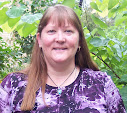[This is one of my honey bees, covered in pollen from golden rod flowers. They bloom in the fall. You'll often see them alongside highways, fields and the woods].
 Pollen comes in many colours such as: White, yellow, red, orange, blue, purple, green and even black .
Pollen comes in many colours such as: White, yellow, red, orange, blue, purple, green and even black .[Can you see the coloured pollen in these honeycomb cells? What colours do you see?]
How does pollen get its colour? From the flower. The next time you see flowers, look at the centers. What colour is the powdery pollen? Every flower has its own unique colour.
 Some flowers such as poppies and tulips can have black pollen. I'm sure the black pollen tastes just as nice as the red or yellow.
Some flowers such as poppies and tulips can have black pollen. I'm sure the black pollen tastes just as nice as the red or yellow.Even tiny flowers can have pollen.
Have you ever stuck your nose into a flower to sniff its perfume? I've done that and I got the yellow powder on my nose. That made me a little bit like a bee.
Have you ever stuck your nose into a flower to sniff its perfume? I've done that and I got the yellow powder on my nose. That made me a little bit like a bee.
 Pollen is part of the life force of a plant and its needed for a plant to produce its babies...seeds. Those seeds will make new flowers.
Pollen is part of the life force of a plant and its needed for a plant to produce its babies...seeds. Those seeds will make new flowers.Flowers have a special relationship with bees and they are reliant on the bees to help them to create their seeds.
Bees have a special relationship with flowers and they are reliant on the flower's pollen to use as food for their babies.
They need each other for their survival: The flower and the bee.
Here's how it works:
Each flower creates its own unique pollen. The pollen on one flower needs to be put into another flower.
But how can it get there? Flowers don't have legs to walk over and mix their pollin into another flower.
 But the flowers know someone who can carry their pollen from one flower to the next. Can use guess who that someone is? Yes, it's the bees.
But the flowers know someone who can carry their pollen from one flower to the next. Can use guess who that someone is? Yes, it's the bees.The bee will fly into a flower. As she digs down into it her fur will become coated with pollen. Her fur is specially designed to hold pollen.
Actually, when a bee flies, her body creates static electricity and that also helps the pollen to stick to her fur. (I'll tell you more about static electricity another time).
 The bee will use her legs to scrape some of that pollen up. Then she'll add some of her spit and honey to it to moisten it. Then she'll stick it to her back leg where there's really stiff hairs that will hold it in place.
The bee will use her legs to scrape some of that pollen up. Then she'll add some of her spit and honey to it to moisten it. Then she'll stick it to her back leg where there's really stiff hairs that will hold it in place.After that she's ready to fly home to drop off her packages. Then she'll go out and look for more flowers and more pollen.
 Pollen is very important to bees because it's full of protein. Baby bee larvae need to eat pollen so they'll grow healthy and strong. Just like how you and I need protein too so we'll grow.
Pollen is very important to bees because it's full of protein. Baby bee larvae need to eat pollen so they'll grow healthy and strong. Just like how you and I need protein too so we'll grow.Some people like to eat pollen as a health food or to help their allergies to flowers to be not so bad. Pollen is nutritious and it's full of vitamins. It tastes like flour with sugar added to it. No wonder the bees like it.
 This is a tray of pollen that a beekeeper has collected. You can see that it's mostly a green colour. The beekeeper will put this pollen in a jar to sell to people. (In another story I'll tell you how the beekeeper collects pollen from the bees).
This is a tray of pollen that a beekeeper has collected. You can see that it's mostly a green colour. The beekeeper will put this pollen in a jar to sell to people. (In another story I'll tell you how the beekeeper collects pollen from the bees).Some flowers don't need bees to mix their pollen for them. Plants like wheat that grows in the field (used to make your bread) are pollinated by the wind blowing.
Most flowering plants also offer Nectar to bees. I'll tell you about that next time.
Do you have a question about bees? If you do, you can leave a question in the comments section or you can contact me through my website: http://www.bee-magic.com/.










